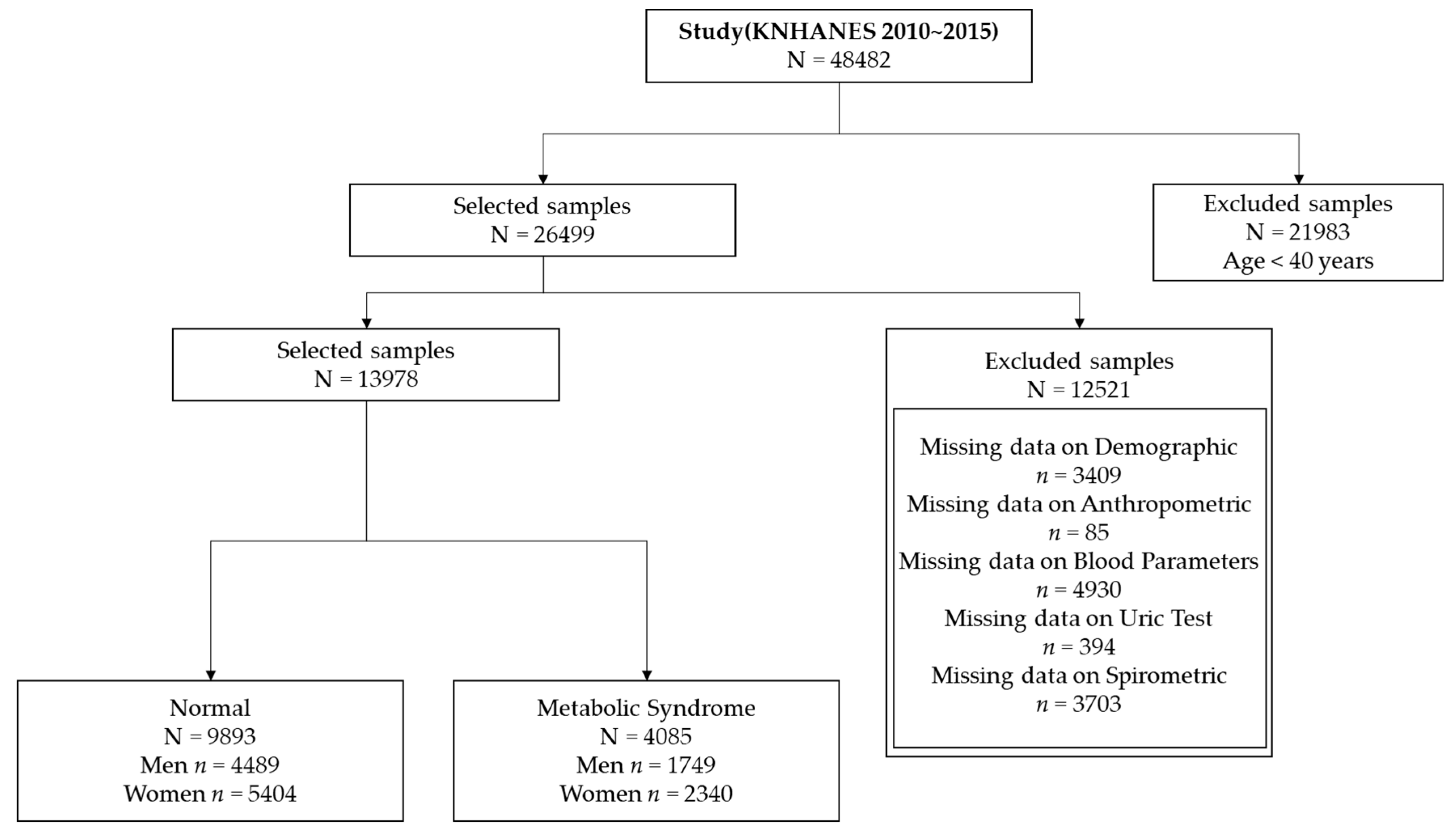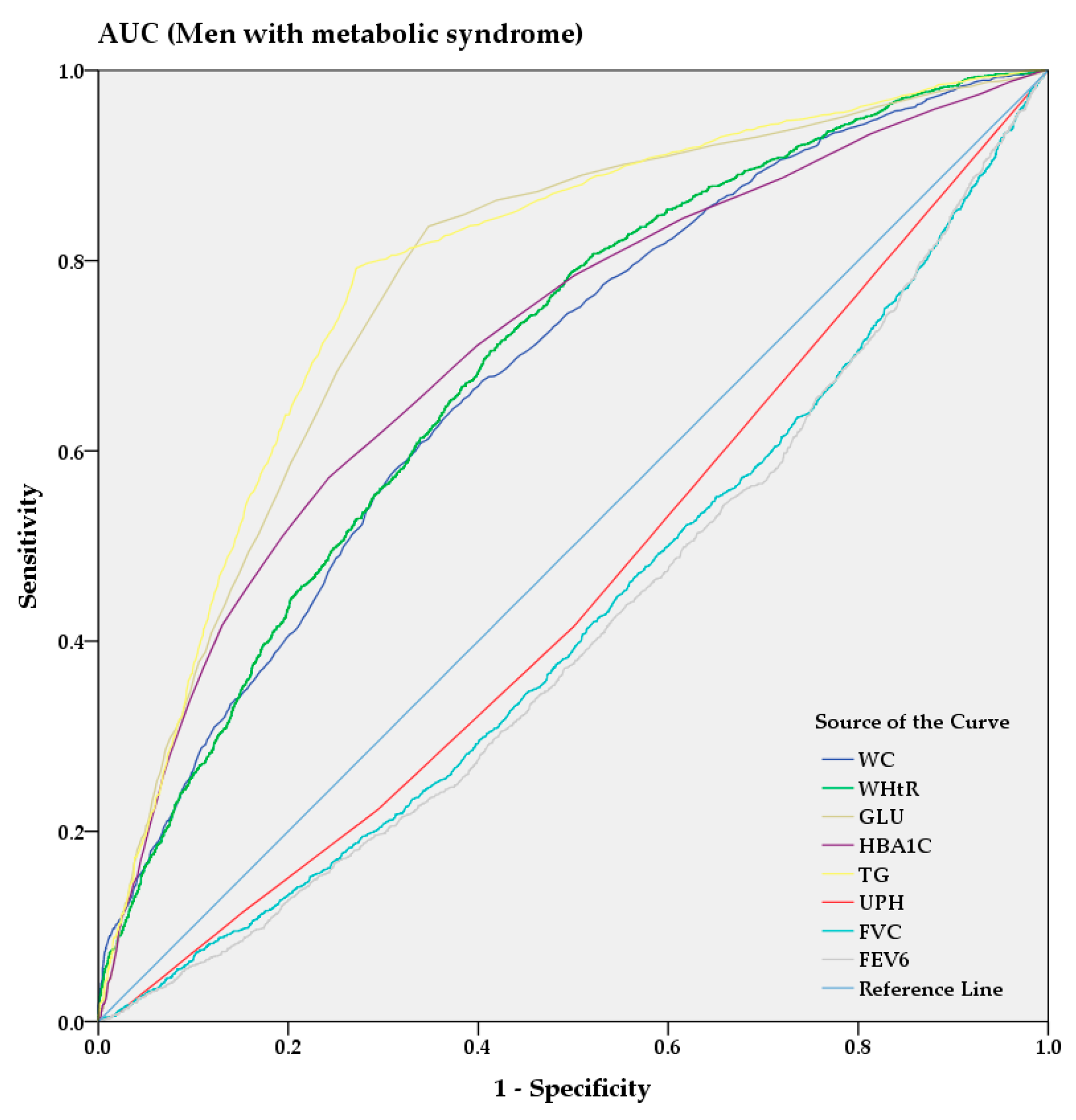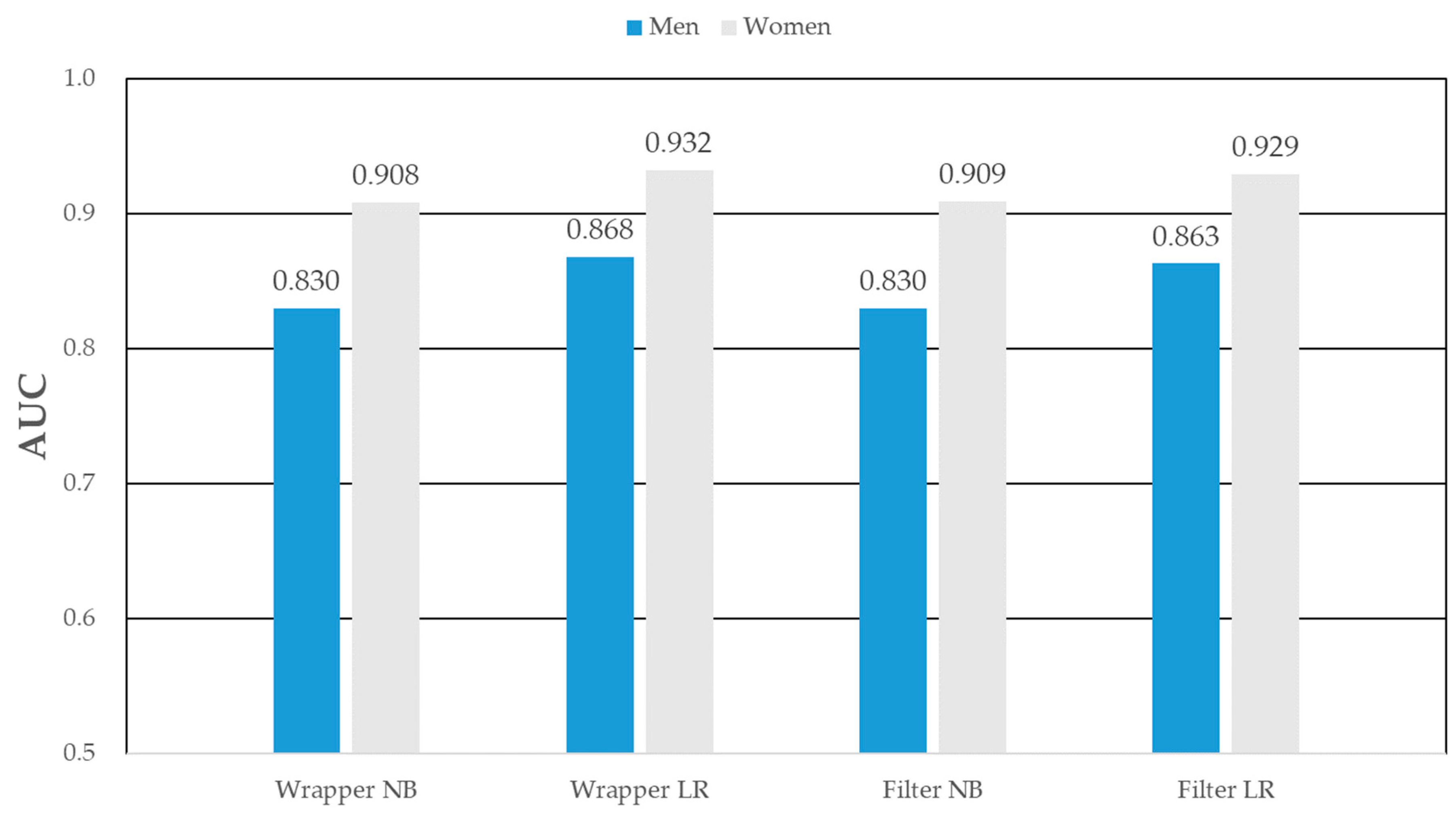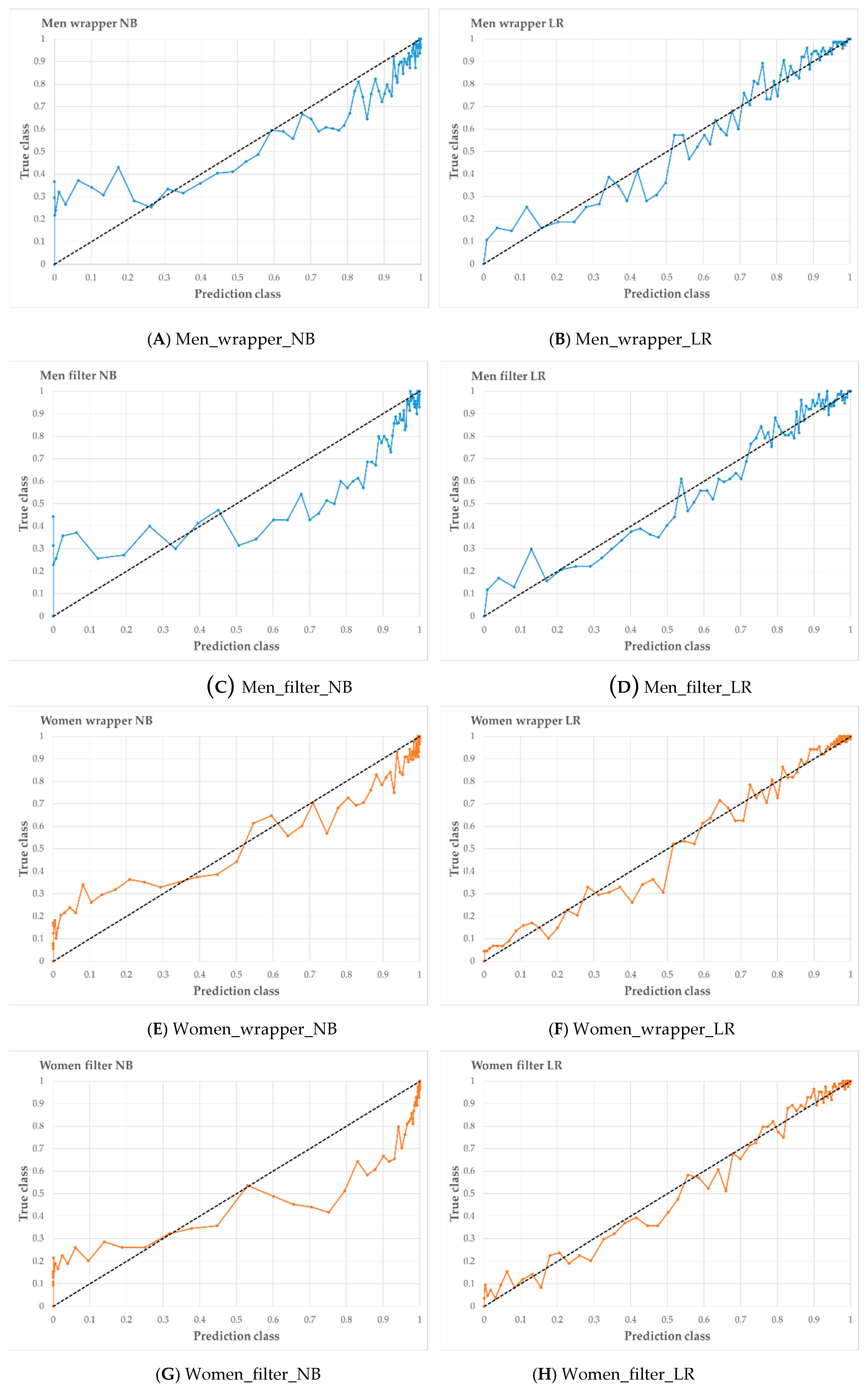Identification of Metabolic Syndrome Based on Anthropometric, Blood and Spirometric Risk Factors Using Machine Learning
Abstract
1. Introduction
2. Materials and Methods
2.1. Subjects and Dataset
2.2. Measurements
2.3. Statistical Analysis
3. Results
3.1. Associations of MS with Anthropometric Factors, Blood Parameters, Urinary Parameters, and Spirometric Factors
3.2. Comparison of the Predictive Power of MS with Anthropometric Factors, Blood Parameters, Urinary Parameters, and Spirometric Factors
4. Discussion
5. Conclusions
Author Contributions
Funding
Acknowledgments
Conflicts of Interest
Abbreviations
References
- Cameron, A.J.; Shaw, J.E.; Zimmet, P.Z. The metabolic syndrome: Prevalence in worldwide populations. Endocrinol. Metab. Clin. N. Am. 2004, 33, 351–375. [Google Scholar] [CrossRef] [PubMed]
- Wilson, P.W.F.; Meigs, J.B. Cardiometabolic risk: A Framingham perspective. Int. J. Obes. 2008, 32, S17–S20. [Google Scholar] [CrossRef] [PubMed]
- Stocks, T.; Hemelrijck, M.V.; Manjer, J.; Bjørge, T.; Ulmer, H.; Hallmans, G.; Lindkvist, B.; Selmer, R.; Nagel, G.; Tretli, S.; et al. Blood pressure and risk of cancer incidence and mortality in the Metabolic Syndrome and Cancer Project. Hypertension 2012, 59, 802–810. [Google Scholar] [CrossRef] [PubMed]
- Boden-Albala, B.; Sacco, R.L.; Lee, H.-S.; Grahame-Clarke, C.; Rundek, T.; Elkind, M.V.; Wright, C.; Giardina, E.-G.V.; DiTullio, M.R.; Homma, S.; et al. Metabolic syndrome and ischemic stroke risk. Stroke 2008, 39, 30–35. [Google Scholar] [CrossRef]
- Korea Center for Disease Control and Prevention. Available online: http://www.cdc.go.kr/ (accessed on 21 August 2020).
- Statistics Research Institute. Available online: http://kostat.go.kr/sri/srikor/index.action (accessed on 21 August 2020).
- Beltrán-Sánchez, H.; Harhay, M.O.; Harhay, M.M.; McElligott, S. Prevalence and trends of metabolic syndrome in the adult U.S. population, 1999–2010. J. Am. Coll. Cardiol. 2013, 62, 697–703. [Google Scholar] [CrossRef]
- Ranasinghe, P.; Mathangasinghe, Y.; Jayawardena, R.; Hills, A.P.; Misra, A. Prevalence and trends of metabolic syndrome among adults in the Asia-Pacific region: A systematic review. BMC Public Health 2017, 17, 101. [Google Scholar] [CrossRef]
- Mannino, D.M.; Thorn, D.; Swensen, A.; Holguin, F. Prevalence and outcomes of diabetes, hypertension and cardiovascular disease in COPD. Eur. Respir. J. 2008, 32, 962–969. [Google Scholar] [CrossRef]
- Schroeder, E.B.; Welch, V.L.; Couper, D.; Nieto, F.J.; Liao, D.; Rosamond, W.D.; Heiss, G. Lung function and incident coronary heart disease: The Atherosclerosis Risk in Communities Study. Am. J. Epidemiol. 2003, 158, 1171–1181. [Google Scholar] [CrossRef]
- Engström, G.; Hedblad, B.; Valind, S.; Janzon, L. Increased incidence of myocardial infarction and stroke in hypertensive men with reduced lung function. J. Hypertens. 2001, 19, 295–301. [Google Scholar] [CrossRef]
- Sagun, G.; Oguz, A.; Karagoz, E.; Filizer, A.T.l.; Tamer, G.; Mesci, B. Application of alternative anthropometric measurements to predict metabolic syndrome. Clinics 2014, 69, 347–353. [Google Scholar] [CrossRef]
- Mooney, S.J.; Baecker, A.; Rundle, A.G. Comparison of anthropometric and body composition measures as predictors of components of the metabolic syndrome in a clinical setting. Obes. Res. Clin. Pract. 2013, 7, e55–e66. [Google Scholar] [CrossRef] [PubMed]
- Hsieh, S.D.; Muto, T. Metabolic syndrome in Japanese men and women with special reference to the anthropometric criteria for the assessment of obesity: Proposal to use the waist-to-height ratio. Prev. Med. 2006, 42, 135–139. [Google Scholar] [CrossRef]
- Shen, W.; Punyanitya, M.; Chen, J.; Gallagher, D.; Albu, J.; Pi-Sunyer, X.; Lewis, C.E.; Grunfeld, C.; Heshka, S.; Heymsfield, S.B. Waist circumference correlates with metabolic syndrome indicators better than percentage fat. Obesity 2006, 14, 727–736. [Google Scholar] [CrossRef] [PubMed]
- Rodea-Montero, E.R.; Evia-Viscarra, M.L.; Apolinar-Jiménez, E. Waist-to-height ratio is a better anthropometric index than waist circumference and BMI in predicting metabolic syndrome among obese Mexican adolescents. Int. J. Endocrinol. 2014, 2014, 1–9. [Google Scholar] [CrossRef]
- Katzmarzyk, P.T.; Church, T.S.; Janssen, I.; Ross, R.; Blair, S.N. Metabolic syndrome, obesity, and mortality: Impact of cardiorespiratory fitness. Diabetes Care 2005, 28, 391–397. [Google Scholar] [CrossRef] [PubMed]
- Williams, D.E.M.; Prevost, A.T.; Whichelow, M.J.; Cox, B.D.; Day, N.E.; Wareham, N.J. A cross-sectional study of dietary patterns with glucose intolerance and other features of the metabolic syndrome. Br. J. Nutr. 2000, 83, 257–266. [Google Scholar] [CrossRef]
- Lao, X.Q.; Neil Thomas, G.; Jiang, C.; Zhang, W.; Adab, P.; Lam, T.H.; Cheng, K.K. White blood cell count and the metabolic syndrome in older Chinese: The Guangzhou Biobank Cohort Study. Atherosclerosis 2008, 201, 418–424. [Google Scholar] [CrossRef]
- Funakoshi, Y.; Omori, H.; Mihara, S.; Marubayashi, T.; Katoh, T. Association between airflow obstruction and the metabolic syndrome or its components in Japanese men. Intern. Med. 2010, 49, 2093–2099. [Google Scholar] [CrossRef]
- McDevitt, R.M.; Poppitt, S.D.; Murgatroyd, P.R.; Prentice, A.M. Macronutrient disposal during controlled overfeeding with glucose, fructose, sucrose, or fat in lean and obese women. Am. J. Clin. Nutr. 2000, 72, 369–377. [Google Scholar] [CrossRef]
- Paek, Y.J.; Jung, K.S.; Hwang, Y.I.; Lee, K.S.; Lee, D.R.; Lee, J.U. Association between low pulmonary function and metabolic risk factors in Korean adults: The Korean National Health and Nutrition Survey. Metabolism 2010, 59, 1300–1306. [Google Scholar] [CrossRef]
- Park, B.H.; Park, M.S.; Chang, J.; Kim, S.K.; Kang, Y.A.; Jung, J.Y.; Kim, Y.S.; Kim, C. Chronic obstructive pulmonary disease and metabolic syndrome: A nationwide survey in Korea. Int. J. Tuberc. Lung Dis. 2012, 16, 694–700. [Google Scholar] [CrossRef] [PubMed]
- Lin, W.Y.; Yao, C.A.; Wang, H.C.; Huang, K.C. Impaired lung function is associated with obesity and metabolic syndrome in adults. Obesity 2006, 14, 1654–1661. [Google Scholar] [CrossRef] [PubMed]
- Wulczyn, E.; Steiner, D.F.; Xu, Z.; Sadhwani, A.; Wang, H.; Flament-Auvigne, I.; Mermel, C.H.; Chen, P.-H.C.; Liu, Y.; Stumpe, M.C. Deep learning-based survival prediction for multiple cancer types using histopathology images. PLoS ONE 2020, 15, e0233678. [Google Scholar] [CrossRef]
- Kopp, W.; Monti, R.; Tamburrini, A.; Ohler, U.; Akalin, A. Deep learning for genomics using Janggu. Nat. Commun. 2020, 11, 1–7. [Google Scholar] [CrossRef] [PubMed]
- Sonogashira, M.; Shonai, M.; Iiyama, M. High-resolution bathymetry by deep-learning-based image superresolution. PLoS ONE 2020, 15, e0235487. [Google Scholar] [CrossRef]
- Davagdorj, K.; Pham, V.H.; Theera-Umpon, N.; Ryu, K.H. XGBoost-based framework for smoking-induced noncommunicable disease prediction. Int. J. Environ. Res. Public Health 2020, 17, 6513. [Google Scholar] [CrossRef]
- Munkhdalai, L.; Munkhdalai, T.; Ryu, K.H. GEV-NN: A deep neural network architecture for class imbalance problem in binary classification. Knowl. Based Syst. 2020, 105534. [Google Scholar] [CrossRef]
- Davagdorj, K.; Lee, J.S.; Pham, V.H.; Ryu, K.H. A comparative analysis of machine learning methods for class imbalance in a smoking cessation intervention. Appl. Sci. 2020, 10, 3307. [Google Scholar] [CrossRef]
- Amarbayasgalan, T.; Park, K.H.; Lee, J.Y.; Ryu, K.H. Reconstruction error based deep neural networks for coronary heart disease risk prediction. PLoS ONE 2019, 14, e0225991. [Google Scholar] [CrossRef]
- Batbaatar, E.; Ryu, K.H. Ontology-based healthcare named entity recognition from Twitter messages using a recurrent neural network approach. Int. J. Environ. Res. Public Health 2019, 16, 3628. [Google Scholar] [CrossRef]
- Ryu, K.S.; Bae, J.-W.; Jeong, M.H.; Cho, M.-C.; Ryu, K.-H.; Investigators, K.A.M.I.R. Risk scoring system for prognosis estimation of multivessel disease among patients with ST-segment elevation myocardial infarction. Int. Hear. J. 2019, 60, 708–714. [Google Scholar] [CrossRef] [PubMed]
- Heo, B.M.; Ryu, K.H. Prediction of prehypertension and hypertension based on anthropometry, blood parameters, and spirometry. Int. J. Environ. Res. Public Health 2018, 15, 2571. [Google Scholar] [CrossRef] [PubMed]
- Piao, Y.; Piao, M.; Ryu, K.H. Multiclass cancer classification using a feature subset-based ensemble from microRNA expression profiles. Comput. Biol. Med. 2017, 80, 39–44. [Google Scholar] [CrossRef]
- Kim, H.; Ishag, M.I.M.; Piao, M.; Kwon, T.; Ryu, K.H. A data mining approach for cardiovascular disease diagnosis using heart rate variability and images of carotid arteries. Symmetry 2016, 8, 47. [Google Scholar] [CrossRef]
- Ryu, K.S.; Park, H.W.; Park, S.H.; Shon, H.S.; Ryu, K.H.; Lee, D.G.; Bashir, M.E.; Lee, J.H.; Kim, S.M.; Lee, S.Y. Comparison of clinical outcomes between culprit vessel only and multivessel percutaneous coronary intervention for ST-segment elevation myocardial infarction patients with multivessel coronary diseases. J. Geriatr. Cardiol. 2015, 12, 208. [Google Scholar]
- Choe, E.K.; Rhee, H.; Lee, S.; Shin, E.; Oh, S.W.; Lee, J.E.; Choi, S.H. Metabolic Syndrome Prediction Using Machine Learning Models with Genetic and Clinical Information from a Nonobese Healthy Population. Genom. Inform. 2018, 16, e31. [Google Scholar] [CrossRef] [PubMed]
- Korea Centers for Disease Control and Prevention: Korea National Health and Nutrition Examination Survey. Available online: https://knhanes.cdc.go.kr/knhanes/eng/index.do (accessed on 20 January 2020).
- Ministry of Health and Welfare of Korea; Korea Centers for Disease Control and Prevention. The Fifth Korea National Health and Nutrition Examination Survey Data User Guide (KNHANES V) 2010–2012; Korea Centers for Disease Control and Prevention Press: Cheongju, Korea, 2012. [Google Scholar]
- Ministry of Health and Welfare of Korea; Korea Centers for Disease Control and Prevention. The Sixth Korea National Health and Nutrition Examination Survey Data User Guide (KNHANES VI) 2013–2015; Korea Centers for Disease Control and Prevention Press: Cheongju, Korea, 2015. [Google Scholar]
- Grundy, S.M.; Cleeman, J.I.; Daniels, S.R.; Donato, K.A.; Eckel, R.H.; Franklin, B.A.; Gordon, D.J.; Krauss, R.M.; Savage, P.J.; Smith, S.C.; et al. Diagnosis and Management of the Metabolic Syndrome. Circulation 2005, 112, 2735–2752. [Google Scholar] [CrossRef]
- Saeys, Y.; Inza, I.; Larrañaga, P. A review of feature selection techniques in bioinformatics. Bioinformatics 2007, 23, 2507–2517. [Google Scholar] [CrossRef]
- Statistics Korea Web Sites. Available online: http://kostat.go.kr (accessed on 1 September 2020).
- Kim, S.Y.; Nam, G.H. Assessment of Anthropometric and Body Composition Risk Factors in Patients with both Hypertension and Stroke in the Korean Population. Appl. Sci. 2020, 10, 3046. [Google Scholar] [CrossRef]
- Kohavi, R. A study of cross-validation and bootstrap for accuracy estimation and model selection. In Proceedings of the 14th International Joint Conference on Artificial Intelligence (IJCAI), Montreal, QC, Canada, 20–25 August 1995; Volume 2, pp. 1137–1145. [Google Scholar]
- Kopitar, L.; Kocbek, P.; Cilar, L.; Sheikh, A.; Stiglic, G. Early detection of type 2 diabetes mellitus using machine learning-based prediction models. Sci. Rep. 2020, 10, 11981. [Google Scholar] [CrossRef]






| Subject | Conditions | Disease |
|---|---|---|
| Waist circumference | Men: ≥102 cm (≥40 inches) Women: ≥88 cm (≥35 inches) | Abdominal obesity |
| Blood pressure | SBP: ≥130 mmHg DBP: ≥85 mmHg | Hypertension |
| Triglycerides | ≥150 mg/dL (1.7 mmol/L) | Hypertriglyceridemia |
| HDL-cholesterol | Men: <40 mg/dL (1.03 mmol/L) Women: <50 mg/dL (1.3 mmol/L) | Dyslipidemia |
| Glucose | ≥100 mg/dL | Diabetes |
| Variable | Men | Women | ||
|---|---|---|---|---|
| Normal | Hypertension | Normal | Hypertension | |
| Subjects, no. (%) | 4489 (72.0%) | 1745 (28.0%) | 5404 (69.8%) | 2340 (30.2%) |
| Age, mean (SD) † | 57.01 (10.97) | 58.95 (10.10) | 55.32 (9.97) | 62.36 (9.66) |
| Height (HT) (cm) † | 168.48 (6.12) | 168.08 (6.09) | 155.9 (5.75) | 154.54 (5.67) |
| Weight (WT) (kg) † | 67.91 (9.24) | 72.54 (10.49) | 56.54 (7.38) | 62.63 (9.24) |
| Waist circumference (WC), (cm) † | 84.57 (7.58) | 89.86 (7.83) | 77.95 (7.53) | 87.61 (8.44) |
| Waist-to-height ratio (WHtR) † | 0.50 (0.05) | 0.53 (0.04) | 0.50 (0.05) | 0.57 (0.06) |
| Body mass index (BMI) (kg/m2) † | 23.88 (2.64) | 25.61 (2.89) | 23.25 (2.69) | 26.19 (3.35) |
| Systolic BP (mmHg) † | 121.00 (15.08) | 128.81 (15.23) | 117.35 (16.57) | 129.49 (16.36) |
| Diastolic BP (mmHg) † | 77.80 (9.83) | 81.2 (11.33) | 74.25 (9.22) | 77.46 (10.32) |
| Glucose (mg/dL) † | 100.62 (21.35) | 120.6 (32.51) | 94.02 (14.06) | 114.63 (30.41) |
| Hemoglobin A1c (HBA1C) (%) † | 5.80 (0.77) | 6.42 (1.16) | 5.68 (0.54) | 6.40 (1.07) |
| Total cholesterol (TC) (mg/dL) * | 190.93 (34.24) | 187 (39.07) | 198.13 (34.45) | 197.13 (39.73) |
| High-density lipid cholesterol (HDL) (mg/dL) † | 48.65 (11.1) | 40.82 (9.55) | 54.90 (12.05) | 45.26 (9.73) |
| Low-density lipid cholesterol (LDL) (mg/dL) † | 118.38 (32.66) | 107.48 (33.28) | 122.33 (32.13) | 118.32 (34.97) |
| Triglycerides (TG) (mg/dL) † | 136.99 (95.58) | 242.71 (176.66) | 104.62 (57.33) | 182.03 (105.83) |
| Aspartate aminotransferase (AST), (IU/L) † | 24.58 (12.95) | 26.89 (13.47) | 21.26 (11.89) | 24.12 (11.10) |
| Alanine aminotransferase (ALT), (IU/L) † | 24.05 (19.12) | 28.94 (17.03) | 17.80 (12.43) | 23.83 (16.51) |
| Hemoglobin (HB) (g/dL) † | 15.09 (1.23) | 15.24 (1.30) | 13.12 (1.11) | 13.38 (1.08) |
| Hematocrit (HCT) (%) * | 44.51 (3.33) | 44.73 (3.53) | 39.54 (2.91) | 40.07 (2.93) |
| Blood urea nitrogen (BUN) (mg/dL) * | 15.69 (4.2) | 16.12 (5.12) | 14.46 (4.01) | 15.42 (4.74) |
| Creatinine (CRT) (mg/dL) * | 0.97 (0.18) | 1.01 (0.31) | 0.72 (0.15) | 0.76 (0.29) |
| White blood cell (WBC) (Thous/uL) † | 6.34 (1.72) | 6.84 (1.80) | 5.55 (1.52) | 6.23 (1.69) |
| Red blood cell (RBC) (Mil/uL) † | 4.79 (0.41) | 4.84 (0.43) | 4.31 (0.32) | 4.39 (0.35) |
| Uric acid pH (UPH) † | 8.51 (1.87) | 8.26 (1.86) | 6.13 (1.17) | 5.71 (0.85) |
| Uric specific gravity (USG) | 5.74 (0.82) | 5.59 (0.76) | 5.83 (0.88) | 1.02 (0.01) |
| Urine creatinine (UCRT) (mg/dL) | 1.02 (0.01) | 1.02 (0.01) | 1.02 (0.01) | 110.86 (61.25) |
| Forced vital capacity (FVC) (L) | 161.08 (76.55) | 158.58 (79.37) | 118.83 (65.57) | 2.75 (0.46) |
| Forced expiratory volume in 1 s (FEV1) | 4.19 (0.70) | 4.01 (0.68) | 3.00 (0.49) | 2.16 (0.42) |
| Ratio of forced expiratory volume in 1 s to forced vital capacity (FEV1FVC) | 3.14 (0.66) | 2.98 (0.64) | 2.39 (0.44) | 0.79 (0.06) |
| Forced expiratory volume in 6 s (FEV6) (L) | 0.75 (0.08) | 0.74 (0.08) | 0.79 (0.06) | 2.67 (0.46) |
| Forced expiratory flow 25–75% (FEF25–75) (L/s) * | 4.02 (0.71) | 3.82 (0.68) | 2.94 (0.50) | 2.35 (0.99) |
| Peak expiratory flow (PEF) (L/s) * | 2.81 (1.29) | 2.8 (1.54) | 2.49 (0.84) | 5.78 (1.22) |
| Variable | Crude | Adjusted | AUC | ||
|---|---|---|---|---|---|
| p-Value | OR [95% CI] | p-Value | OR [95% CI] | ||
| Age | <0.0001 | 1.272 [1.196–1.352] | 0.555 [0.540–0.570] | ||
| Anthropometric factors | |||||
| HT | <0.05 | 0.918 [0.858–0.982] | 0.8655 | 0.993 [0.914–1.078] | 0.480 [0.464–0.496] |
| WT | <0.0001 | 1.592 [1.485–1.706] | 0.9151 | 1.008 [0.865–1.175] | 0.623 [0.608–0.639] |
| WC | <0.0001 | 2.069 [1.922–2.228] | <0.0001 | 1.468 [1.287–1.674] | 0.683 [0.668–0.697] |
| WHtR | <0.0001 | 2.164 [2.006–2.334] | <0.0001 | 1.511 [1.311–1.742] | 0.694 [0.680–0.709] |
| BMI | <0.0001 | 1.902 [1.763–2.052] | 0.667 [0.652–0.682] | ||
| Blood parameters | |||||
| GLU | <0.0001 | 2.348 [2.048–2.691] | <0.0001 | 2.165 [1.923–2.438] | 0.776 [0.764–0.789] |
| HBA1C | <0.0001 | 1.906 [1.703–2.133] | <0.0001 | 1.797 [1.633–1.978] | 0.712 [0.697–0.726] |
| TC | 0.2372 | 0.957 [0.889–1.030] | 0.0929 | 0.935 [0.865–1.011] | 0.464 [0.448–0.481] |
| HDL | <0.0001 | 0.385 [0.347–0.427] | <0.0001 | 0.384 [0.342–0.431] | 0.276 [0.261–0.290] |
| TG | <0.0001 | 2.719 [2.350–3.146] | <0.0001 | 2.711 [2.328–3.158] | 0.787 [0.775–0.799] |
| AST | <0.05 | 1.144 [1.025–1.276] | <0.05 | 1.102 [1.018–1.193] | 0.574 [0.558–0.590] |
| ALT | <0.05 | 1.250 [1.052–1.484] | 0.1358 | 1.134 [0.961–1.338] | 0.619 [0.603–0.634] |
| HB | <0.0001 | 1.155 [1.075–1.240] | <0.05 | 1.095 [1.009–1.188] | 0.533 [0.517–0.550] |
| HCT | <0.05 | 1.088 [1.016–1.166] | 0.5084 | 1.027 [0.950–1.109] | 0.516 [0.500–0.532] |
| BUN | <0.05 | 1.117 [1.044–1.195] | 0.2716 | 1.042 [0.968–1.123] | 0.516 [0.500–0.532] |
| CRT | <0.05 | 1.199 [1.063–1.353] | <0.0001 | 1.261 [1.172–1.358] | 0.547 [0.531–0.563] |
| WBC | <0.0001 | 1.316 [1.235–1.403] | <0.05 | 1.134 [1.046–1.230] | 0.587 [0.571–0.603] |
| RBC | <0.05 | 1.143 [1.069–1.223] | <0.05 | 1.134 [1.046–1.230] | 0.532 [0.516–0.548] |
| Urinary parameters | |||||
| UPH | <0.0001 | 0.823 [0.767–0.883] | <0.0001 | 0.852 [0.791–0.918] | 0.451 [0.436–0.467] |
| USG | 0.6728 | 1.014 [0.949–1.084] | 0.6370 | 1.018 [0.945–1.096] | 0.485 [0.469–0.501] |
| UCRT | 0.6667 | 0.985 [0.919–1.056] | 0.9480 | 1.003 [0.928–1.083] | 0.484 [0.468–0.500] |
| Spirometric factors | |||||
| FVC | <0.0001 | 0.755 [0.706–0.807] | <0.0001 | 0.839 [0.769–0.915] | 0.423 [0.407–0.438] |
| FEV1 | <0.0001 | 0.772 [0.723–0.825] | <0.05 | 0.850 [0.770–0.940] | 0.424 [0.408–0.439] |
| FEV1FVC | <0.05 | 0.933 [0.875–0.994] | 0.6219 | 1.021 [0.941–1.106] | 0.471 [0.455–0.487] |
| FEV6 | <0.0001 | 0.733 [0.685–0.784] | <0.0001 | 0.822 [0.749–0.903] | 0.413 [0.398–0.429] |
| FEF25–75 | 0.4195 | 0.971 [0.904–1.043] | <0.05 | 1.123 [1.035–1.219] | 0.475 [0.459–0.491] |
| PEF | <0.05 | 0.882 [0.825–0.944] | 0.4528 | 0.966 [0.884–1.057] | 0.457 [0.441–0.473] |
| Variable | Crude | Adjusted | AUC | ||
|---|---|---|---|---|---|
| p-Value | OR [95% CI] | p-Value | OR [95% CI] | ||
| Age | <0.0001 | 2.070 [1.946–2.202] | 0.696 [0.683–0.708] | ||
| Anthropometric factors | |||||
| HT | <0.0001 | 0.763 [0.719–0.808] | <0.0001 | 1.188 [1.097–1.287] | 0.429 [0.415–0.443] |
| WT | <0.0001 | 2.197 [2.046–2.358] | <0.0001 | 1.411 [1.212–1.643] | 0.700 [0.687–0.713] |
| WC | <0.0001 | 4.011 [3.647–4.411] | <0.0001 | 2.847 [2.447–3.313] | 0.808 [0.797–0.819] |
| WHtR | <0.0001 | 4.166 [3.795–4.572] | <0.0001 | 2.564 [2.194–2.996] | 0.813 [0.802–0.823] |
| BMI | <0.0001 | 2.922 [2.699–3.164] | 0.758 [0.746–0.770] | ||
| Blood parameters | |||||
| GLU | <0.0001 | 4.593 [3.818–5.524] | <0.0001 | 3.377 [2.828–4.033] | 0.810 [0.799–0.821] |
| HBA1C | <0.0001 | 3.504 [3.022–4.063] | <0.0001 | 2.466 [2.161–2.813] | 0.776 [0.765–0.788] |
| TC | 0.1381 | 1.050 [0.984–1.119] | 0.4955 | 0.974 [0.903–1.051] | 0.486 [0.472–0.501] |
| HDL | <0.0001 | 0.318 [0.290–0.348] | <0.0001 | 0.348 [0.313–0.386] | 0.255 [0.244–0.267] |
| TG | <0.0001 | 3.723 [3.266–4.244] | <0.0001 | 3.515 [3.042–4.062] | 0.796 [0.785–0.807] |
| AST | <0.0001 | 1.433 [1.274–1.612] | <0.05 | 1.174 [1.055–1.306] | 0.601 [0.587–0.615] |
| ALT | <0.0001 | 1.588 [1.363–1.849] | <0.0001 | 1.301 [1.153–1.467] | 0.671 [0.658–0.684] |
| HB | <0.0001 | 1.316 [1.229–1.409] | <0.0001 | 1.206 [1.119–1.300] | 0.567 [0.553–0.581] |
| HCT | <0.0001 | 1.245 [1.165–1.330] | <0.05 | 1.122 [1.046–1.204] | 0.551 [0.537–0.565] |
| BUN | <0.0001 | 1.247 [1.167–1.333] | 0.6779 | 0.986 [0.920–1.056] | 0.557 [0.543–0.571] |
| CRT | <0.05 | 1.265 [1.057–1.515] | <0.05 | 1.143 [1.006–1.299] | 0.548 [0.533–0.562] |
| WBC | <0.0001 | 1.431 [1.346–1.522] | <0.0001 | 1.315 [1.225–1.413] | 0.626 [0.613–0.640] |
| RBC | <0.0001 | 1.305 [1.222–1.395] | <0.0001 | 1.294 [1.206–1.389] | 0.567 [0.553–0.581] |
| Urinary parameters | |||||
| UPH | <0.0001 | 0.862 [0.812–0.915] | <0.0001 | 0.834 [0.781–0.891] | 0.413 [0.400–0.427] |
| USG | 0.4582 | 0.979 [0.926–1.035] | 0.1512 | 0.951 [0.887–1.019] | 0.464 [0.451–0.478] |
| UCRT | <0.05 | 0.903 [0.852–0.957] | 0.4165 | 0.971 [0.904–1.043] | 0.485 [0.472–0.499] |
| Spirometric factors | |||||
| FVC | <0.0001 | 0.583 [0.544–0.624] | <0.05 | 0.882 [0.809–0.962] | 0.465 [0.452–0.479] |
| FEV1 | <0.0001 | 0.590 [0.551–0.631] | <0.05 | 0.898 [0.818–0.985] | 0.351 [0.338–0.364] |
| FEV1FVC | <0.0001 | 0.855 [0.806–0.907] | 0.5393 | 1.024 [0.949–1.106] | 0.352 [0.339–0.365] |
| FEV6 | <0.0001 | 0.566 [0.528–0.607] | <0.05 | 0.872 [0.798–0.954] | 0.460 [0.447–0.474] |
| FEF25–75 | <0.0001 | 0.843 [0.781–0.911] | <0.05 | 1.150 [1.060–1.246] | 0.344 [0.331–0.357] |
| PEF | <0.0001 | 0.734 [0.689–0.781] | 0.2660 | 1.045 [0.967–1.130] | 0.433 [0.419–0.447] |
| Sex | Method | Num. of Features | Features | |
|---|---|---|---|---|
| Men | Wrapper | Naïve Bayes | 13 | Age, WT, WC, SBP, Glucose, HDL, TG, ALT, WBC, USG, UCREA, FVC, FEV6 |
| Logistic Regression | 15 | HT, WC, WHtR, SBP, DBP, Glucose, HBA1C, TC, HDL, TG, HB, HCT, CREA, WBC, RBC | ||
| Filter | CFS | 8 | WHtR, SBP, Glucose, HDL, TG, AST, CREA, RBC | |
| Women | Wrapper | Naïve Bayes | 9 | WC, WHtR, SBP, DBP, Glucose, HDL, TG, RBC, UPH |
| Logistic Regression | 12 | Age, WT, WC, SBP, Glucose, TC, HDL, TG, AST, BUN, UPH, FEV1FVC | ||
| Filter | CFS | 11 | WC, WHtR, SBP, Glucose, HBA1C, HDL, TG, ALT, CREA, WBC, FEF25-75 | |
| Sex | Prediction Model | Class | Sensitivity | 1-Specificity | Precision | F-Measure |
|---|---|---|---|---|---|---|
| Men | Wrapper NB | Normal | 0.904 | 0.488 | 0.826 | 0.863 |
| Metabolic | 0.512 | 0.096 | 0.674 | 0.582 | ||
| Wrapper LR | Normal | 0.926 | 0.449 | 0.841 | 0.882 | |
| Metabolic | 0.551 | 0.074 | 0.742 | 0.633 | ||
| Filter NB | Normal | 0.919 | 0.598 | 0.798 | 0.854 | |
| Metabolic | 0.402 | 0.081 | 0.659 | 0.499 | ||
| Filter LR | Normal | 0.924 | 0.469 | 0.835 | 0.877 | |
| Metabolic | 0.531 | 0.076 | 0.730 | 0.615 | ||
| Women | Wrapper NB | Normal | 0.905 | 0.262 | 0.888 | 0.896 |
| Metabolic | 0.738 | 0.095 | 0.770 | 0.754 | ||
| Wrapper LR | Normal | 0.930 | 0.261 | 0.892 | 0.911 | |
| Metabolic | 0.739 | 0.070 | 0.821 | 0.778 | ||
| Filter NB | Normal | 0.923 | 0.334 | 0.864 | 0.893 | |
| Metabolic | 0.666 | 0.077 | 0.788 | 0.722 | ||
| Filter LR | Normal | 0.927 | 0.275 | 0.886 | 0.906 | |
| Metabolic | 0.725 | 0.073 | 0.811 | 0.766 |
| Sex | Prediction Model | AUC | AUPRC | R2 | RMSE |
|---|---|---|---|---|---|
| Men | Wrapper NB | 0.830 [0.821–0.839] | 0.616 [0.604–0.628] | 0.899 [0.892–0.907] | 0.396 [0.384–0.408] |
| Wrapper LR | 0.868 [0.860–0.876] | 0.712 [0.701–0.723] | 0.960 [0.955–0.965] | 0.358 [0.346–0.370] | |
| Filter NB | 0.830 [0.821–0.839] | 0.604 [0.592–0.616] | 0.802 [0.792–0.812] | 0.407 [0.395–0.419] | |
| Filter LR | 0.863 [0.854–0.872] | 0.703 [0.692–0.714] | 0.952 [0.947–0.958] | 0.361 [0.349–0.373] | |
| Women | Wrapper NB | 0.908 [0.902–0.914] | 0.788 [0.779–0.797] | 0.969 [0.965–0.973] | 0.341 [0.330–0.352] |
| Wrapper LR | 0.932 [0.926–0.938] | 0.851 [0.843–0.859] | 0.986 [0.983–0.988] | 0.308 [0.298–0.318] | |
| Filter NB | 0.911 [0.905–0.917] | 0.783 [0.774–0.792] | 0.915 [0.908–0.921] | 0.352 [0.341–0.363] | |
| Filter LR | 0.929 [0.923–0.935] | 0.843 [0.835–0.851] | 0.986 [0.983–0.988] | 0.311 [0.301–0.321] |
Publisher’s Note: MDPI stays neutral with regard to jurisdictional claims in published maps and institutional affiliations. |
© 2020 by the authors. Licensee MDPI, Basel, Switzerland. This article is an open access article distributed under the terms and conditions of the Creative Commons Attribution (CC BY) license (http://creativecommons.org/licenses/by/4.0/).
Share and Cite
Kim, S.Y.; Nam, G.H.; Heo, B.M. Identification of Metabolic Syndrome Based on Anthropometric, Blood and Spirometric Risk Factors Using Machine Learning. Appl. Sci. 2020, 10, 7741. https://doi.org/10.3390/app10217741
Kim SY, Nam GH, Heo BM. Identification of Metabolic Syndrome Based on Anthropometric, Blood and Spirometric Risk Factors Using Machine Learning. Applied Sciences. 2020; 10(21):7741. https://doi.org/10.3390/app10217741
Chicago/Turabian StyleKim, Sang Yeob, Gyeong Hee Nam, and Byeong Mun Heo. 2020. "Identification of Metabolic Syndrome Based on Anthropometric, Blood and Spirometric Risk Factors Using Machine Learning" Applied Sciences 10, no. 21: 7741. https://doi.org/10.3390/app10217741
APA StyleKim, S. Y., Nam, G. H., & Heo, B. M. (2020). Identification of Metabolic Syndrome Based on Anthropometric, Blood and Spirometric Risk Factors Using Machine Learning. Applied Sciences, 10(21), 7741. https://doi.org/10.3390/app10217741






